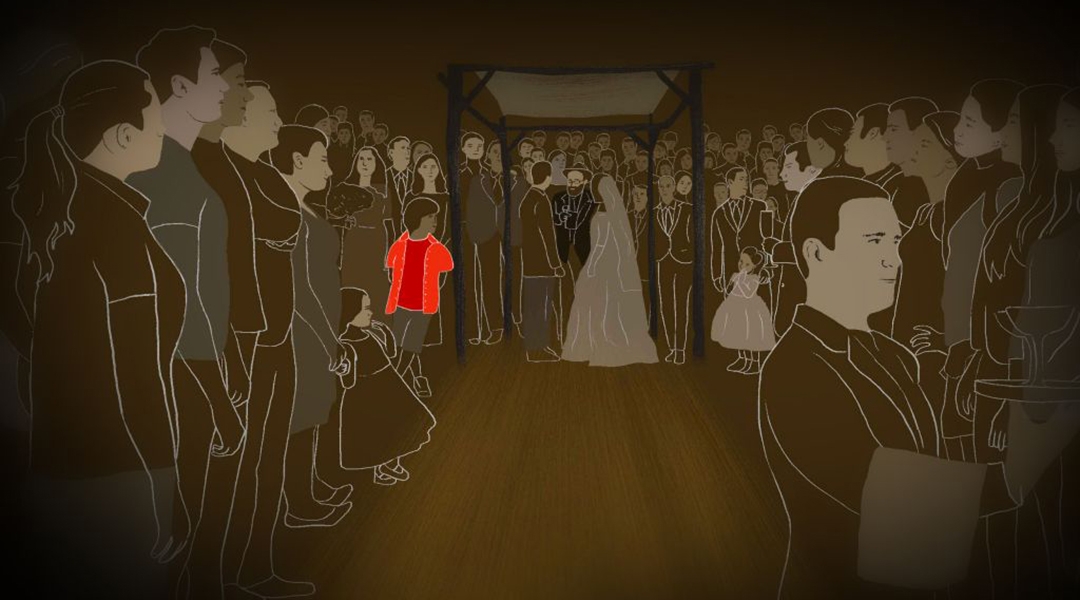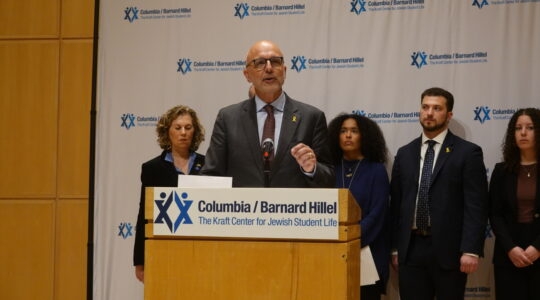Jerusalem – He was an acquaintance, someone Sarah* had known for years, so she didn’t worry when she found herself alone with him one wintery day.
She discovered she was pregnant soon after he raped her. In her thirties, childless and aching to be a mother, she decided to raise this unexpected baby on her own.
Back then Sarah, who had divorced a few years earlier in a U.S. civil court, had no idea that her child could be considered a “mamzer” – the closest thing Judaism has to a bastard or an untouchable – not because her child was conceived during a rape, but because, according to Jewish law, Sarah had been married when she was raped.
A mamzer is a Jew born from an incestuous relationship or a relationship between a married Jewish woman and a Jewish man who isn’t her husband.
According to Jewish law, a mamzer can only marry another mamzer or a convert. “Mamzerut” – mamzer status – is inherited, so all descendants of a mamzer will be a mamzer, till the end of time.
Like hundreds. perhaps thousands, of other Jewish women whose husbands are unable or unwilling to grant them a “get,” a Jewish writ of divorce, Sarah was an “agunah,” a chained woman stuck in marital limbo. Her vindictive husband had skipped town, his whereabouts unknown.
Jewish law forbids a wife from conceiving a child with another man, even if her husband is missing in action, physically or mentally incapacitated, a convict, held hostage, has abandoned her or simply refuses to divorce her.
Though Sarah had no formal Jewish education, she knew that without a get she would be unable to marry again in a Jewish ceremony. But she didn’t know that that a child conceived through a sexual relationship forbidden by the Torah could be marginalized and stigmatized.
She was shocked when a boyfriend broke the news to her.
“I began dating a Jewishly knowledgeable guy, and he freaked out when he heard I didn’t have a get,” Sarah recalled in a hushed telephone interview from her home in a large American city.
“He said we couldn’t get married and also that any child we would have together would be a mamzer, just like my daughter. I had no idea what he was talking about.”
“Mamzerut is at the very core of the agunah problem, of Jewish patriarchy and the control male rabbis maintain over Jewish women’s bodies and behavior.”
When Sarah learned about the prohibitions imposed on mamzerim and their descendants “it sounded like something out of the Dark Ages,” she said, her voice quivering.
Support the New York Jewish Week
Our nonprofit newsroom depends on readers like you. Make a donation now to support independent Jewish journalism in New York.
Years later, Sarah, whose daughter is in elementary school, “still finds it unbelievable that in the 21st century, ancient religious laws that give men all the power can turn my child into an outcast.”
She isn’t alone.
For the first time in Jewish history, a small number of mostly Orthodox Jewish activists are publicly demanding that the world’s rabbis use their authority to find a comprehensive, universally accepted solution to mamzerut, a status that, according to Susan Weiss, a women’s rights lawyer, would likely affect “an inconceivably large number” of Jews if their family histories became public. The issue is receiving the most attention in Israel.
“Mamzerut is at the very core of the agunah problem, of Jewish patriarchy and the control male rabbis maintain over Jewish women’s bodies and behavior. It’s a socially constructed apparatus to deter women from sleeping with men who aren’t their husbands,” said Weiss, who heads the Jerusalem-based Center for Women’s Justice, an Israeli NGO that has represented several mamzerim and their families in Israel’s religious and civil courts.
This is especially true in Israel, Weiss said, where there is no civil marriage. The Orthodox religious establishment — not the secular civil court system — oversees Jewish marriage, divorce and personal status issues.
Though mamzerut has been around for more than 2,000 years, wars and migration often enabled families to hide their status under the Talmudic principle that a mamzer who has managed to blend into the wider Jewish community is permitted to remain “assimilated” into the community.
“This is no longer the case,” says Batya Kahana-Dror, a women’s rights lawyer and director of Mevoi Satum, a Jerusalem agunah rights organization. “Now, in modern times, our world is very data-driven. Things don’t get lost as easily.”
The advent of the internet, digital recordkeeping and do-it-yourself DNA testing, along with the ever-more-stringent standards adopted by Orthodox rabbis, especially in Israel, “is making it nearly impossible for families to safeguard their secret,” Kahana-Dror said.
Mamzer (MAHM-zer;) Plural: mamzerim (MAHM-zer-im). Lit. bastard
Mamzerut is as old as the Torah but remains shrouded in stigma, secrecy and shame.
It is so taboo that people don’t utter the word mamzer in polite company outside of Torah study. It’s used as a curse word, roughly equivalent to bastard.
Support the New York Jewish Week
Our nonprofit newsroom depends on readers like you. Make a donation now to support independent Jewish journalism in New York.
The Torah mentions the word only twice, in passages that fail to define who a mamzer is or the prohibitions he or she faces.
Mamzerut is as old as the Torah but remains shrouded in stigma, secrecy and shame.
Deuteronomy 23:2 states that “a mamzer shall not enter the congregation of the Lord; even to his tenth generation shall he not enter into the congregation of the Lord.” Zachariah 9:6 states that “a mamzer shall dwell in [the port city of] Ashdod and will cut off the pride of the Philistines.”
For two millennia Judaism’s most esteemed scholars interpreted and defined mamzerut and established its strictures in books of Jewish law and subsequent responsa. According to Orthodox tradition these opinions have the status of law and can’t be repealed. Different religious streams have taken different approaches toward mamzerut. The Reform movement has abolished the category entirely while the Conservative movement has adopted a Don’t Ask, Don’t Tell policy.
Orthodox rabbis, in contrast, continue to apply these rules to determine paternity and who can marry whom.
Rivka Lubitch, a rabbinic pleader who represents clients in Israel’s religious court system and also works with the Center for Women’s Justice, says this generation’s most influential Orthodox rabbis aren’t doing nearly enough to eradicate, or even mitigate, the tragedy of mamzerut. Instead, Lubitch said, “they continue to wield the threat of mamzerut to pressure wives into acceding to their husbands’ demands to relinquish property, child support payments and the custody of their children.”
Eager to get on with their lives and to have children not stained by mamzerut, women seeking divorce often give in to their husbands’ demands
Divorce, Lubitch maintained, “is driven by the fear and stigma surrounding mamzerut. Rabbis know that mothers will do almost anything to protect their children, and once there is a solution to mamzerut the rabbis will lose much of that power.”
The Curse That Keeps On Giving
On paper, the only thing mamzerim can’t do is marry a normative Jew. Other than this, mamzerim can be active members of the Jewish community and inherit property. But in reality, the stigma of mamzerut is so great, even in some non-Orthodox circles, that 53 percent of Israeli women who sought legal abortions in 2014 cited “illicit relations, from incest or extramarital affairs” as their reason for doing so, according to the Ministry of Health.
Weiss suspects that some of these women cited illicit relations not because their unborn child could be a mamzer but because “this is the fastest way to get approved for an abortion.”
In traditional Jewish society, where getting married and having children is both a social norm and an obligation laid out by the Torah, the strictures placed on mamzerim “are catastrophic,” Lubitch said.
Support the New York Jewish Week
Our nonprofit newsroom depends on readers like you. Make a donation now to support independent Jewish journalism in New York.
For this reason women who don’t terminate their pregnancies, often go to extraordinary lengths to hide their child’s status. Some put their child up for adoption while others pretend that their husband or ex-husband is the biological father.
Israel’s 1965 Population Registry Law and 2000 Genetic Information Law both encourage this fiction by adopting the rabbinic presumption that a child born within 300 days of a divorce is the biological child of the ex-husband. With rare exceptions Israeli courts prohibit DNA testing for paternity purposes because it could prove a child’s mamzer status.
Rabbi Yona Reiss, an Orthodox Torah scholar, attorney and head of the Beit Din of the Chicago Rabbinical Council, says rabbis understand the gravity of mamzerut and therefore “try to find grounds for leniency, according to halacha,” or Jewish law.
In cases of marital infidelity, the rabbis attempt to invalidate the marriage. This approach is easier in the U.S., where non-Orthodox and civil marriages are an option.
“We may look at the wedding invitation, and if the wedding was held on a Saturday afternoon, there’s a good chance it wasn’t performed according to halacha,” Rabbi Reiss said. “Was the marriage officiant a rabbi or a justice of the peace? And if it was a rabbi, it’s possible he or the witnesses weren’t Shabbat observant,” he noted in seeking ways to solve the problem by invalidating the marriage.
According to Orthodox standards, witnesses to a marriage must be Shabbat observant.
Weiss from the Center for Women’s Justice says these rabbinic presumptions and loopholes, though perhaps originally well-intentioned and helpful in some instances, aren’t applicable in all cases. And even when they are applicable, they leave mamzer children in a literal no man’s land.
On the one hand, she said, “when a woman’s husband realizes the child isn’t his, he refuses to support the child, and the rabbis, knowing the truth, won’t force him to do so. This man certainly doesn’t want this child of another man to inherit his property.”
On the other hand, the child’s biological father has no legal status whatsoever in his child’s life.
Paternal presumption is so strong that civil courts in Israel have upheld it on several occasions to spare a child from possibly being labeled a mamzer, even when doing so has robbed the mother of child support payments from the biological father.
Hospitals and government institutions follow the same policy.
Yifat,* an American-Israeli woman represented by the Center for Women’s Justice, hit the paternal presumption wall when she wanted to list her child’s biological father on his birth certificate.
Support the New York Jewish Week
Our nonprofit newsroom depends on readers like you. Make a donation now to support independent Jewish journalism in New York.
Seated on a bench in an isolated part of a Jerusalem park, out of earshot of others, the young mother quietly related how, after years of begging for a get, her ex-husband agreed to grant one, but only if the divorce took place in a private ultra-Orthodox rabbinical court and not the Chief Rabbinate.
The government-funded rabbinate has sole authority over marriage and divorce in Israel.
“I was afraid of remaining an agunah so I reluctantly agreed,” said Yifat, an Orthodox Jew who covers her hair with a scarf for reasons of religious modesty. “My private divorce was completely kosher, and I eventually remarried, also in a private rabbinical court, because I knew the rabbinate wouldn’t recognize my private get.”
The problems began in the hospital where Yifat gave birth to a baby boy, the son of her second husband.
“The clerk who registers births saw that my first husband’s name was on my Israeli I.D. card – in the eyes of the state I was still married to him – and began to write his name under ‘Father.’ When I objected and gave him my second husband’s name, the clerk refused to put it on the certificate. He said, ‘Are you telling me your husband isn’t your baby’s father?’
Ultimately the clerk wrote “unknown” on the birth certificate, what Weiss calls “a red flag” for mamzer status.
When the rabbinate refused to recognize Yifat’s ultra-Orthodox get, the Center for Women’s Justice petitioned the civil family court to determine her child’s paternity.
Apparently fearful that the civil court would preempt its authority, the rabbinical court finally recognized Yifat’s get retroactively, ensuring that her son would not be labeled a mamzer.
The Most Marginalized Group
Rivka Lubitch, a rabbinic pleader who represents clients in Israel’s religious court system and is the country’s most outspoken advocate for mamzerim, insists that the courts, the legislature or both must help them because they can’t advocate for themselves. “This is the mamzer’s dilemma: The issue needs to be out in the open, but who will do it? If you or your child are the ones affected, you keep quiet. And if you’ve somehow solved the problem, you are the last person in the world who wants to bring this out into the open.”
Not surprisingly, Lubitch said, mamzerim are hopelessly isolated and marginalized.
“People with physical disabilities can meet other people with disabilities. If you’re homosexual you can find a like-minded community. There is no such community of mamzerim. The rabbis tell each one of them that their problem must be dealt with quietly, behind closed doors. News of the problem almost never gets out and nobody knows there’s a problem. If people don’t know there’s a problem, no one is interested in solving it.”
Support the New York Jewish Week
Our nonprofit newsroom depends on readers like you. Make a donation now to support independent Jewish journalism in New York.
If you ask a Jew whether he or she has ever met a mamzer, the answer will almost certainly be no, Lubitch said. “This despite the fact that plenty of cases aren’t solved and many people don’t know if their case can be solved. If they try to find out it can lead to more problems.”
Lubitch recounted the case of an adopted young man who asked Social Services to unseal his adoption records.
“The first thing the social worker did was tell him he’s a mamzer. He feels like his life is ruined.”
Compounding the problem is the uncertainty; he has no way of knowing whether the rabbinate is aware of his status.
“That’s not something a person would know until applying for a marriage license. Meanwhile, he or she is filled with anxiety, wondering ‘who will marry me?’ One’s mental health is deteriorating,” Lubitch said.
Cases like this aren’t uncommon, according to Rabbi Seth Farber, an Israeli Orthodox rabbi and founder of ITIM, an organization that helps mamzerim and others navigate the religious establishment’s bureaucracy.
“Sometimes people are already aware their status is in question,” Farber said. “But often, these people only discover they have a problem when they walk into the rabbinate’s marriage office,” where everyone’s name is processed through a national registry of who can and can’t marry.
“What makes mamzerut so devastating is that it affects innocent children who have had nothing to do with the creation of their own status.”
Anyone with a questionable status is immediately sent to a rabbinical court for clarification. Farber said experiences like this can turn off even religious Jews from Judaism, especially in cases where the rabbinate is responsible for a mamzer’s status to begin with.
In one case, the rabbinate declared that four children were mamzerim because it stopped trusting the rabbi who facilitated their mother’s Orthodox get.
In another case the rabbinate realized it had accidentally permitted a long-ago marriage between a woman and her ex-husband’s brother. Under the incest law, such marriages result in mamzerut if the ex-husband is still living.
Regardless of the circumstances, “what makes mamzerut so devastating is that it affects innocent children who have had nothing to do with the creation of their own status,” Farber said.
Support the New York Jewish Week
Our nonprofit newsroom depends on readers like you. Make a donation now to support independent Jewish journalism in New York.
Mamzerut In The Digital Age
Until a few years ago, anyone who used the services of the rabbinate found themselves in offices where folders overflowing with paper records were stacked and toppling over. Today, most of these records, including the lists of Jews who are ineligible to marry or whose Jewish status is “questionable,” are computerized.
Farber, whose ITIM organization utilized Israel’s Freedom of Information law to learn the exact number of people on each list, discovered something surprising: During the past five years, only four people have been added to the list of mamzerim and another four to the list of questionable mamzerim.
“This doesn’t make sense because our assistance center has received calls related to at least 20 mamzerut cases during this period,” Farber said. “My guess is there are tens, possibly hundreds of cases of suspected mamzerut that have remained open for years and years without any progress being made to close them. They aren’t reflected in these numbers.”
As of May 2017, there were 85 people listed on the rabbinate’s mamzer list and 146 on the list of suspected mamzerim, according to the rabbinate.
Farber said the number of mamzerim and suspected mamzerim could rise dramatically in the future because the rabbinate no longer automatically accepts the authority of many Orthodox diaspora rabbis.
“This means that if an Orthodox rabbi outside of Israel effects a Jewish divorce, the former spouses might remarry. But down the road, the rabbinate might not accept the divorce. This would make their children mamzerim.”
Farber worries, too, that a World Jewish Database proposed by Israel’s Ministry of Religious Affairs with the cooperation of the rabbinate is intended to allow the rabbinate to extend its authority and strict criteria over world Jewry. Such a database would make it impossible for mamzerim and others to maintain their privacy.
Rabbinical lists aren’t the only threat to a mamzer’s privacy. The growing popularity of genealogical research and personal DNA testing via home kits “raises the possibility of finding out things people don’t want to know, and that includes mamzerut,” says Israel Pickholtz, a professional genetic genealogist in Jerusalem. “There have been several such cases.”
Are There Solutions?
Farber, whose ITIM organization has represented mamzerim and suspected mamzerim in Israeli courts, is convinced that Jewish law provides the tools to prevent and even eliminate mamzer status. He asserted that prominent rabbis “are often afraid to use them. They’re afraid of being perceived as too liberal or too flexible.”
Support the New York Jewish Week
Our nonprofit newsroom depends on readers like you. Make a donation now to support independent Jewish journalism in New York.
In an era of unprecedented sexual freedom, the ultra-Orthodox rabbis that control the rabbinate and rabbinical courts see themselves as Judaism’s gatekeepers, said Farber. The problem with this gatekeeper mentality, he said, is that it conflicts with the longstanding rabbinical principle to assume someone is not a mamzer unless there’s incontrovertible evidence.
“Traditionally, community rabbis and local rabbinical courts resolved these issues before there were actual consequences. When they couldn’t, the mamzer usually went to another community where no one knew his status.”
Farber accused the Israeli rabbis who dictate national religious policy of “cutting themselves off” from the public they’re serving.
The Rabbinate and the rabbinical court system declined to comment on this or any matter related to mamzerut.
Recognizing that secrecy has not solved the mamzer problem, activists recently began to reach out to Israeli lawmakers and the public as well. For the very first time, last March a Knesset session devoted to agunot featured a segment on mamzerut.
In another first, Israeli filmmaker and artist Nurit Jacobs-Yinon spearheaded a group art exhibition entitled “Mamzerim, Labeled and Erased” at the 2017 Jerusalem Biennale that included a book, Mamzerim, of scholarly essays.
Significantly, most of the activists – many of them Modern Orthodox women – neither expect nor want leading rabbis to break religious law to free mamzerim of their status.
“What we want is for the rabbis to utilize the resources provided by Jewish law,” Nitzan Caspi Shiloni, a Center for Women’s Justice attorney who has has represented several mamzerim and their families in Israel’s religious and civil courts.
“But most lack the courage to do so. Those that do face the wrath of their peers.”
If it were up to Lubitch, the world’s rabbis would rule that all Jews are mamzerim, a move that would allow all Jews to marry one another within the strictures of Orthodox law. “This is the biggest, most moral solution,” Lubitch said, “but what rabbi will want to do that? It’s like saying ‘I’m contaminated.’”
By far the most promising solution involves reproductive technology.
Rabbi Aryeh Katz, an expert in fertility and Jewish law, said artificial insemination may provide a solution for some mamzerim who don’t want to pass the status on to their children.
Support the New York Jewish Week
Our nonprofit newsroom depends on readers like you. Make a donation now to support independent Jewish journalism in New York.
“The question is, does mamzerut result from the union of the sperm and the egg, or is it the result of sexual relations between a man and a woman? Most rabbinic decisors say it results from an illicit sexual union,” said Katz, a halachic researcher at the Puah Institute, an organization that helps infertile Jews in accordance with strict Jewish law.
Asked whether a child born to a female mamzer via IVF with a donated egg implanted into her body, or via a surrogate mother with the female mamzer’s egg would be considered a mamzer, Katz was non-committal.
“It’s complex and depends on who is considered the mother of the child according to halacha — the woman who donated the ovum or the pregnant woman. Since today there is no clear decision on the subject, the answer is that the child is probably a mamzer. But there may be religious courts that say mamzerut is not inherited through in vitro fertilization in order to make it easier, but this is a difficult question.”
However, if a female mamzer utilizes a surrogate mother to have a baby with eggs that don’t belong to the mamzer, “it is considered a case of adoption and the child would not be a mamzer,” Katz said.
Whether mamzerim choose to go any of these routes will depend largely on which rabbis, if any, they follow.
The late Rabbi Moshe Feinstein, considered by many to be the greatest Orthodox posek [decisor] of the 20th century, ruled that artificial insemination with donor sperm does not result in mamzerut, thus leaving the door open for fertility treatments.
But Rabbi Yoel Teitelbaum, the late Grand Rabbi of the chasidic Satmar community, held that if a married Jewish woman is impregnated with another man’s sperm even via fertility treatments, it is adultery and will produce a mamzer.
Batya Kahana-Dror, a women’s rights lawyer and director of Mevoi Satum, a Jerusalem agunah rights organization, believes artificial insemination with donated sperm could allow agunot to have children. But she noted that Orthodox rabbis in Israel and abroad continue to prohibit this.
In another attempt to prevent mamzerut, the Center for Women’s Justice has drawn up a power of attorney that permits a rabbinic court to grant a get to a woman, if necessary, instead of her husband.
Lost In Limbo
Were the rabbinical courts to accept innovate halachic documents like the Center for Women’s Justice Pledge of Compassion, they could free women like Talya*, whose husband suffered a brain aneurysm several years ago. (The Pledge document, signed by a husband, is a power of attorney appointing an agent to deliver a get to the wife in the event that he becomes medically or mentally unable to do so himself.)
Support the New York Jewish Week
Our nonprofit newsroom depends on readers like you. Make a donation now to support independent Jewish journalism in New York.
The aneurysm left Talya’s husband paralyzed, blind and with the cognitive abilities of a preschooler.
“We were very happily married,” Talya, an Israeli who lives in central Israel, said during an emotional telephone interview.
For the first several months after her husband’s brain bleed, Talya stopped working to be by his side in the hospital and, later, rehab.
“I’ve been very angry at times, angry because it’s in the hands of the rabbis to help and they don’t help.”
“We had a young child and I was terrified. I wondered what will be? At first I was afraid he wouldn’t survive and then, after almost a year of rehabilitation he stopped making progress. I couldn’t care for him on my own so I found a long-term facility. Now he’s in a nursing home, half the age of the other residents.”
After a couple of years, with no hope that her husband would recover, Talya decided to divorce him. “I wanted a new life, I wanted more kids. I filed for divorce and the rabbinical court judges said they understood and wanted to help, but that it will be very difficult. Because even though my husband is like a child, he had to agree to divorce me.”
The rabbis visited the husband in his nursing home several times over a period of months and asked whether he would agree to divorce Talya, who was then in her late 30s, and he said no.
She has since consulted many rabbis and enlisted the help of Mevoi Satum, the agunah advocacy organization.
Now in her forties, Talya said she has found love again, with another man.
“We decided we wouldn’t wait until my divorce was finalized. I got pregnant, had a baby, and have built a new life. It’s a good life.”
Even so, Talya didn’t tell anyone but close family about her pregnancy until she was 27 weeks along.
Unless she receives a retroactive get, the child she had with her partner will remain a mamzer.
Talya, who is secular, said she refuses to think about mamzerut.
Support the New York Jewish Week
Our nonprofit newsroom depends on readers like you. Make a donation now to support independent Jewish journalism in New York.
“I just want her to have a life.”
“For me, a child is a child. Since I gave birth I have put the issue aside. We don’t talk about it at all because we believe there will be a solution.”
She admits that her spirits sometimes falter.
“I’ve been very angry at times, angry because it’s in the hands of the rabbis to help and they don’t help.”
It took Sarah, the American woman whose daughter was conceived during a rape, more than a decade to procure a get with the help of an Israeli women’s rights organization. The process cost her thousands of dollars in legal fees and plane tickets to Israel, and left her traumatized and depressed.
But Sarah, who has since found solace in her Jewish heritage, said it was worth the emotional and financial toll.
“My daughter is Jewish. She is here, she is a miracle, and I want her to have the choice to become more religious if she wants to be. Or not. I want her to be able to get married and have children without the threat of mamzerut hanging over her like a shadow.
“I just want her to have a life.”
*All of the people affected by mamzerut interviewed for this article requested pseudonyms.
Michele Chabin’s reporting was made possible by a grant from The Fund for Investigative Journalism and a fellowship with the Schuster Institute for Investigative Journalism, with support from the Ford Foundation.





